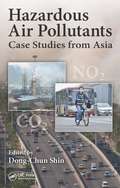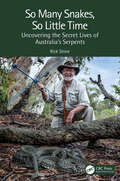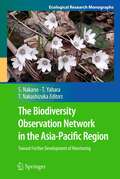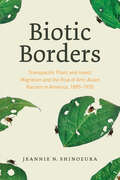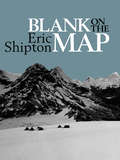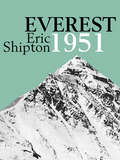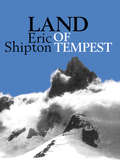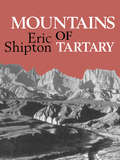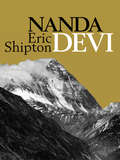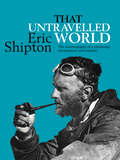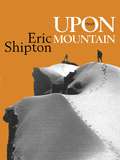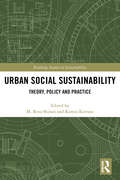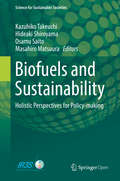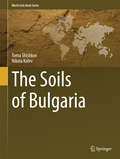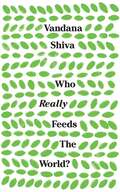- Table View
- List View
Understanding Environmental Education: From Theory to Practices in India
by Chong ShimrayThe book establishes the importance of environmental education by tracing its history and the developments that have taken place subsequently to date. It provides basic understanding about environmental education as well as valuable suggestions for its effective incorporation in the school curriculum. The strength of the book lies in its content as all major areas of environmental education have been addressed such as school curriculum, professional development, and policies, especially in the context of India, thus making it a unique and go-to resource for all stakeholders working in the field of environmental education. The well-balanced content will help readers appreciate the nature of environmental education and its distinctiveness from other subject disciplines as well as environmental studies and environmental science substantiated with several examples and illustrations. What is striking about the book is its proposed road map which is critical for successful implementation of environmental education in India with the launch of the National Education Policy 2020 and the subsequent introduction of new curriculum frameworks. The book will be useful to students, preservice teachers, and teacher educators. It will also be of much value to in-service teachers, practitioners in different settings, teachers, policy makers, curriculum developers, and researchers in the field of environmental education.
Understanding Environmental Education: From Theory to Practices in India
by Chong ShimrayThe book establishes the importance of environmental education by tracing its history and the developments that have taken place subsequently to date. It provides basic understanding about environmental education as well as valuable suggestions for its effective incorporation in the school curriculum. The strength of the book lies in its content as all major areas of environmental education have been addressed such as school curriculum, professional development, and policies, especially in the context of India, thus making it a unique and go-to resource for all stakeholders working in the field of environmental education. The well-balanced content will help readers appreciate the nature of environmental education and its distinctiveness from other subject disciplines as well as environmental studies and environmental science substantiated with several examples and illustrations. What is striking about the book is its proposed road map which is critical for successful implementation of environmental education in India with the launch of the National Education Policy 2020 and the subsequent introduction of new curriculum frameworks. The book will be useful to students, preservice teachers, and teacher educators. It will also be of much value to in-service teachers, practitioners in different settings, teachers, policy makers, curriculum developers, and researchers in the field of environmental education.
Hazardous Air Pollutants: Case Studies from Asia
by Dong-Chun ShinHazardous Air Pollutants: Case Studies from Asia examines the variety of public health problems, such as cardiovascular disease, respiratory disease, increased mortality, and impaired mental health, that are severely affecting multiple Asian countries as a result of exposure to high concentrations of air pollution in the wake of rapid industrializa
So Many Snakes, So Little Time: Uncovering the Secret Lives of Australia’s Serpents
by Rick ShineSnakes are creatures of mystery, arousing fear in many people but fascination in a few. Recent research has transformed our understanding of the behaviour and ecology of these animals, revealed their important roles in diverse ecosystems, and discovered new and effective ways to conserve their populations and to promote coexistence between snakes and people. One of the leading contributors to that scientific revolution has been Prof Rick Shine. Based in Australia, whose snake fauna is diverse and often dangerous, his experiences and anecdotes will inspire a new generation of serpent scientists. Spellbinding stories highlight the challenges, frustrations, and joys of discovery, and give the reader a greater appreciation of these often-slandered slithering reptiles.Key Features Documents the important role played by a preeminent herpetologist. Focuses on research conducted in Australia, especially on snakes. Summarizes highly influential conservation studies. Explores the ways in which research has deepened our understanding of snakes.
So Many Snakes, So Little Time: Uncovering the Secret Lives of Australia’s Serpents
by Rick ShineSnakes are creatures of mystery, arousing fear in many people but fascination in a few. Recent research has transformed our understanding of the behaviour and ecology of these animals, revealed their important roles in diverse ecosystems, and discovered new and effective ways to conserve their populations and to promote coexistence between snakes and people. One of the leading contributors to that scientific revolution has been Prof Rick Shine. Based in Australia, whose snake fauna is diverse and often dangerous, his experiences and anecdotes will inspire a new generation of serpent scientists. Spellbinding stories highlight the challenges, frustrations, and joys of discovery, and give the reader a greater appreciation of these often-slandered slithering reptiles.Key Features Documents the important role played by a preeminent herpetologist. Focuses on research conducted in Australia, especially on snakes. Summarizes highly influential conservation studies. Explores the ways in which research has deepened our understanding of snakes.
Handbook of Environmental Contaminants: A Guide for Site Assessment
by Chris ShineldeckerHandbook of Environmental Contaminants: A Guide for Site Assessment is an indispensable working reference for environmental assessment professionals faced with determining potential environmental contaminants that might be found in the soil, groundwater, or air of a property or facility. The book provides a comprehensive listing of potential contaminants associated with hundreds of industries, activities, and processes. The types of properties covered range from agricultural to heavy industrial. The products and processes covered range from the processing of yeast to the constituents of rocket fuel. The book also discusses products associated with the degradation of common chemical solvents in the environment.Handbook of Environmental Contaminants: A Guide for Site Assessment is an important reference for environmental consultants, workers on Superfund sites, public health and safety professionals, attorneys, educators and students, and lenders.
Handbook of Environmental Contaminants: A Guide for Site Assessment
by Chris ShineldeckerHandbook of Environmental Contaminants: A Guide for Site Assessment is an indispensable working reference for environmental assessment professionals faced with determining potential environmental contaminants that might be found in the soil, groundwater, or air of a property or facility. The book provides a comprehensive listing of potential contaminants associated with hundreds of industries, activities, and processes. The types of properties covered range from agricultural to heavy industrial. The products and processes covered range from the processing of yeast to the constituents of rocket fuel. The book also discusses products associated with the degradation of common chemical solvents in the environment.Handbook of Environmental Contaminants: A Guide for Site Assessment is an important reference for environmental consultants, workers on Superfund sites, public health and safety professionals, attorneys, educators and students, and lenders.
The Biodiversity Observation Network in the Asia-Pacific Region: Toward Further Development of Monitoring (Ecological Research Monographs)
by Shin-ichi Nakano, Tetsukazu Yahara and Tohru NakashizukaBiological diversity is important for ecosystem function and services, which in turn is essential for human well-being. Under the Convention on Biological Diversity, international efforts have been made to achieve a significant reduction in the current rate of biodiversity loss. The loss continues, however. The Asia-Pacific region includes both developing countries with high biodiversity and developed countries with sophisticated data collection and analyses, but only limited information about the status quo of biodiversity in this region has been available. Many Asia-Pacific countries have rapidly grown their economies and social infrastructures, causing a loss of biodiversity and requiring an urgent mandate to achieve a balance between development and conservation in the region. In December 2009, scientists successfully organized the Asia-Pacific Biodiversity Observation Network in the region, to establish a network for research and monitoring of ecosystems and biodiversity and to build a cooperative framework. The present volume is the first collection of information on biodiversity in the Asia-Pacific and represents a quantum step forward in science that optimizes the synergy between development and biodiversity conservation.
Biotic Borders: Transpacific Plant and Insect Migration and the Rise of Anti-Asian Racism in America, 1890–1950
by Jeannie N. ShinozukaA rich and eye-opening history of the mutual constitution of race and species in modern America. In the late nineteenth century, increasing traffic of transpacific plants, insects, and peoples raised fears of a "biological yellow peril" when nursery stock and other agricultural products shipped from Japan to meet the growing demand for exotics in the United States. Over the next fifty years, these crossings transformed conceptions of race and migration, played a central role in the establishment of the US empire and its government agencies, and shaped the fields of horticulture, invasion biology, entomology, and plant pathology. In Biotic Borders, Jeannie N. Shinozuka uncovers the emergence of biological nativism that fueled American imperialism and spurred anti-Asian racism that remains with us today. Shinozuka provides an eye-opening look at biotic exchanges that not only altered the lives of Japanese in America but transformed American society more broadly. She shows how the modern fixation on panic about foreign species created a linguistic and conceptual arsenal for anti-immigration movements that flourished in the early twentieth century. Xenophobia inspired concerns about biodiversity, prompting new categories of “native” and “invasive” species that defined groups as bio-invasions to be regulated—or annihilated. By highlighting these connections, Shinozuka shows us that this story cannot be told about humans alone—the plants and animals that crossed with them were central to Japanese American and Asian American history. The rise of economic entomology and plant pathology in concert with public health and anti-immigration movements demonstrate these entangled histories of xenophobia, racism, and species invasions.
Biotic Borders: Transpacific Plant and Insect Migration and the Rise of Anti-Asian Racism in America, 1890–1950
by Jeannie N. ShinozukaA rich and eye-opening history of the mutual constitution of race and species in modern America. In the late nineteenth century, increasing traffic of transpacific plants, insects, and peoples raised fears of a "biological yellow peril" when nursery stock and other agricultural products shipped from Japan to meet the growing demand for exotics in the United States. Over the next fifty years, these crossings transformed conceptions of race and migration, played a central role in the establishment of the US empire and its government agencies, and shaped the fields of horticulture, invasion biology, entomology, and plant pathology. In Biotic Borders, Jeannie N. Shinozuka uncovers the emergence of biological nativism that fueled American imperialism and spurred anti-Asian racism that remains with us today. Shinozuka provides an eye-opening look at biotic exchanges that not only altered the lives of Japanese in America but transformed American society more broadly. She shows how the modern fixation on panic about foreign species created a linguistic and conceptual arsenal for anti-immigration movements that flourished in the early twentieth century. Xenophobia inspired concerns about biodiversity, prompting new categories of “native” and “invasive” species that defined groups as bio-invasions to be regulated—or annihilated. By highlighting these connections, Shinozuka shows us that this story cannot be told about humans alone—the plants and animals that crossed with them were central to Japanese American and Asian American history. The rise of economic entomology and plant pathology in concert with public health and anti-immigration movements demonstrate these entangled histories of xenophobia, racism, and species invasions.
Blank on the Map: Pioneering exploration in the Shaksgam valley and Karakoram mountains.
by Eric Shipton'As I studied the maps, one thing about them captured my imagination … Across this blank space was written one challenging word, "Unexplored"' In 1937 two of the twentieth century's greatest explorers set off to explore an unknown area of the Himalaya, the breath-taking Shaksgam mountains. With a team of surveyors and Sherpas, Eric Shipton and H.W. Tilman located and mapped the land around K2, the second-highest mountain in the world. It was their greatest venture, and one that paved the way for all future mountaineering in that area of the Himalaya. For Shipton and Tilman, exploration was everything, with a summit a welcome bonus, and Blank on the Map is the book that best captures their spirit of adventure. With an observant eye and keen sense of humour, Shipton tells how the expedition entered the unknown Shaksgam mountains, crossing impenetrable gorges, huge rivers and endless snow fields. There's a very human element to in Shipton's dealings with his Sherpa friends, and with his Balti porters, some of whom were helpful, while some were less so. The expedition uncovers traces of ancient cultures and visits vibrant modern civilisations living during the last days of the British Empire. Only when all supplies are exhausted, their clothes in tatters and all equipment lost do the men finally return home. A mountain exploration classic.
Everest 1951: The Mount Everest Reconnaissance Expedition (Eric Shipton: The Mountain Travel Books #1)
by Eric ShiptonIn 1953, Edmund Hillary and Tenzing Norgay reached the summit of Mount Everest. They climbed from the south, from Nepal, via the Khumbu Glacier - a route first pioneered in 1951 by a reconnaissance expedition led by Eric Shipton. Everest 1951 is the account of this expedition. It was the first to approach the mountain from the south side, it pioneered a route through the Khumbu icefall and it was the expedition on which Hillary set foot on Everest for the first time. Everest 1951 is a short but vitally important read for anybody with any interest in mountaineering or in Everest. The 1951 Everest Expedition marked the public highpoint of Shipton's mountaineering fame. Key information was discovered and the foundations laid for future success. Despite this, Shipton's critics felt he had a 'lack of trust' and thus failed to match the urgent mood of the period. Despite having been on more Everest expeditions than any man alive, he was 'eased' out of the crucial leadership role in 1953 and so missed the huge public acclaim given to Hillary, Tenzing Norgay and John Hunt after their historic success.
Land of Tempest: Travels in Patagonia: 1958-1962
by Eric ShiptonLand of Tempest reveals Shipton at his best - writing with enthusiasm and humour about his explorations in Patagonia in the 1950s and 1960s. He is an astute observer of nature and the human spirit, and this account of his travels is infused with with his own zest for discovery and the joy of camaraderie. Undaunted by hardship or by injury, Shipton and his team attempt to cross one of the great ice-caps in Patagonia. It’s impossible not to marvel at his determination, resilience and appetite for travel and adventure, be it climbing snow-clad mountains, or walking in forested foothills. Shipton takes a reader with him on his travels, and the often-inhospitable places he visits are a stark contrast to the warmth of the people he encounters. Land of Tempest is essential reading for anyone who loves nature, mountains, climbing, adventure or simply the joy of discovering unknown places.
Mountains of Tartary: Mountaineering and exploration in northern and central Asia in the 1950s
by Eric ShiptonIn Undiscovered Scotland climbing and mountaineer W.H. Murray transports the reader to the wilds of Scotland, exploring the hills and climbing on ice, rock and snow. Murray, a former prisoner of war, is relishing his freedom – all the sweeter following his captivity – and we follow him on his adventures in Scotland to the Isle of Rum, Skye, Glencoe and the Cuillin as he enjoys the fellowship, struggles, pleasures and beauty which mountain climbing bestows upon him. Here are the joys of the high mountains, the sun glinting on burn pools, and the peace of wilderness evenings. Undiscovered Scotland is Murray’s second book. Like his first, Mountaineering in Scotland, it is hailed as one of the great classics of mountain literature; poetic and inspirational for any keen climber, walker or mountaineer, even the armchair kind. ‘The touch of wind on the cheek, rocks, the smell of pines and bog-myrtle, morning dew and the song of water, snow-ridges in sun, tall trees and corries. Let us see their beauty and remember … ’
Nanda Devi: Nanda Davi Exploration And Ascent (Nanda Davi Exploration and Ascent #1)
by Eric Shipton'When a man is conscious of the urge to explore, not all the arduous journeyings, the troubles that will beset him and the lack of material gains from his investigations will stop him.' Nanda Devi is one of the most inaccessible mountains in the Himalaya. It is surrounded by a huge ring of peaks, among them some of the highest mountains in the Indian Himalaya. For fifty years the finest mountaineers of the early twentieth century had repeatedly tried and failed to reach the foot of the mountain. Then, in 1934, Eric Shipton and H. W. Tilman found a way in. Their 1934 expedition is regarded as the epitome of adventurous mountain exploration. With their three tough and enthusiastic Sherpa companions Angtharkay, Kusang and Pasang, they solved the problem of access to the Nanda Devi Sanctuary. They crossed difficult cols, made first ascents and explored remote, uninhabited valleys, all of which is recounted in Shipton's wonderfully vivid Nanda Devi - a true evocation of Shipton's enduring spirit of adventure and one of the most inspirational travel books ever written.
That Untravelled World: The autobiography of a pioneering mountaineer and explorer (Eric Shipton: The Mountain Travel Books)
by Eric Shipton‘It is often from our setbacks, even our weaknesses, that we derive some of our greatest blessings.’That Untravelled World is the autobiography of one of the greatest adventurers of the twentieth century. Eric Shipton was a pioneering explorer, journeying to places that did not feature on maps and to unexplored mountains, such as the High Dauphiné.Shipton describes early childhood days filled with adventures; his first encounter with the high mountains on a visit to the Pyrenees, and the onset of his climbing career inspired by travels in Norway with a friend. He reminisces on first meeting infamous explorer H.W. ‘Bill’ Tilman, and their first expedition together to Mount Kenya. Tilman and Shipton were later to become one of the most famous climbing partnerships of all time.Filled with anecdotes from different periods of his life, Shipton takes us on his journey from Kilimanjaro and Mount Stanley alongside Tilman, his discovery of the route to the Nanda Devi Sanctuary, summiting Mount Kamet with mountaineering icon Frank Smythe, and multiple expeditions to Everest.First published in 1969, That Untravelled World is the story of an adventurer who, inspired by Edward Whymper, travelled to feral landscapes across the globe, and has in turn inspired generations of climbers and mountaineers.
Upon That Mountain: The first autobiography of the legendary mountaineer Eric Shipton
by Eric ShiptonUpon that Mountain is the first autobiography of the mountaineer and explorer Eric Shipton. In it, he describes all his pre-war climbing, including his Everest bids of the 1930s, and his second Karakoram survey in 1939, when he returned to Snow Lake to complete the mapping of the ranges flanking the Hispar and Choktoi glacier systems around the Ogre. Crossing great swathes of the Himalaya, the book, like so many of Shipton’s works, is both entertaining and an important addition to the mountain literature genre. It captures an important period in mountaineering history - that just before the Second World War - an ends on an elegiac note as Shipton describes his last evening at the starkly-beautiful snow lake, before he returns to a ‘civilisation’ about to embark on a cataclysmic war.
Urban Social Sustainability: Theory, Policy and Practice (Routledge Studies in Sustainability)
by M. Reza Shirazi Ramin KeivaniThis ground breaking volume raises radical critiques and proposes innovative solutions for social sustainability in the built environment. Urban Social Sustainability provides an in-depth insight into the discourse and argues that every urban intervention has a social sustainability dimension that needs to be taken into consideration, and incorporated into a comprehensive and cohesive ‘urban agenda’ that is built on three principles of recognition, integration, and monitoring. This should be achieved through a dialogical and reflexive process of decision-making. To achieve sustainable communities, social sustainability should form the basis of a constructive dialogue and be interlinked with other areas of sustainable development. This book underlines the urgency of approaching social sustainability as an urban agenda and goes on to make suggestions about its formulation. Urban Social Sustainability consists of original contributions from academics and experts within the field and explores the significance of social sustainability from different perspectives. Areas covered include urban policy, transportation and mobility, urban space and architectural form, housing, urban heritage, neighbourhood development, and urban governance. Drawing on case studies from a number of countries and world regions the book presents a multifaceted and interdisciplinary understanding from social sustainability in urban settings, and provides practitioners and policy makers with innovative recommendations to achieve more socially sustainable urban environment.
Biofuels and Sustainability: Holistic Perspectives for Policy-making (Science for Sustainable Societies)
by Hideaki Shiroyama Osamu Saito Kazuhiko Takeuchi Masahiro MatsuuraThis open access book presents a comprehensive analysis of biofuel use strategies from an interdisciplinary perspective using sustainability science. This interdisciplinary perspective (social science-natural science) means that the strategies and policy options proposed will have significant impacts on the economy and society alike. Biofuels are expected to contribute to reducing greenhouse gas emissions, revitalizing economies in agricultural communities and alleviating poverty. However, despite these anticipated benefits, international organizations such as the FAO, OECD and UN have published reports expressing concerns that biofuel promotion may lead to deforestation, water pollution and water shortages. The impacts of biofuel use are extensive, cross-sectoral and complex, and as such, comprehensive analyses are required in order to assess the extent to which biofuels can contribute to sustainable societies. Applying interdisciplinary sustainability science concepts and methodologies, the book helps to enhance the establishment of a sustainable society as well as the development of appropriate responses to a global need for urgent action on current issues related to biofuels.
The Soils of Bulgaria (World Soils Book Series)
by Toma Shishkov Nikola KolevThe Soils of Bulgaria offers a comprehensive analysis of the characteristics of soils and concepts on their magnitude. The purpose of the book is to introduce readers to the soil problematic and ecology in Bulgaria. The volume is divided into 3 parts. The first includes historical facts on soil research in Bulgaria, as well as general conditions and factors of soil formation, while the second applies an original pedological approach. The book’s third part focuses on essential information concerning land use/cover in Bulgaria. Each of the 13 chapters deals more specifically with fundamental chemical and physical soil properties, concepts of soil evolution, old and modern processes, geographic distribution, climatic conditions, topography, parent materials, plant associations, morphology and the relationship with different classification systems. The interactions between soil status and management are also highlighted. The use of the latest, statistically significant data ensures precise conclusions. The book also includes a large number of charts and new illustrations. The Soils of Bulgaria is crucial reading material for anyone interested in soil management and agriculture in Easter Europe, from students to policy makers and is also of particular interest for researchers in the field.
Gully Erosion Studies from India and Surrounding Regions (Advances in Science, Technology & Innovation)
by Pravat Kumar Shit Hamid Reza Pourghasemi Gouri Sankar BhuniaThis book offers the scientific basis for the ample evaluation of badland management in India and some surrounding regions. It examines the processes operating in the headwaters and main channels of ephemeral rivers in lateritic environments of India. In particular, the book covers a range of vital topics in the areas of gully erosion and water to soil erosion at lateritic uplands regions of India and other regions in Asia. It explores the probable gully erosion modeling through Remote Sensing & GIS Techniques. It is divided into three units. Unit I deals with the introduction of badland, types of badland and the process of badland formation. Unit II is devoted to a description of quantitative measurements. Unit III deals with the control and management processes related to various issues from different regions. As such this book serves as a reference book for research activities in this area. It is an efficient guide for aspiring researchers in applied geography, explaining advanced techniques to help students recognize both simple and complex concepts.
Who Really Feeds the World?: The Failures Of Agribusiness And The Promise Of Agroecology
by Vandana Shiva'One of the world's most prominent radical scientists.'The Guardian'A star among environmental, activist, and anti-corporate circles.'ViceThe world's food supply is in the grip of a profound crisis. Humanity's ability to feed itself is threatened by a wasteful, globalized agricultural industry, whose relentless pursuit of profit is stretching our planet's ecosystems to breaking point. Rising food prices have fuelled instability across the world, while industrialized agriculture has contributed to a health crisis of massive proportions, with effects ranging from obesity and diabetes to cancers caused by pesticides.In Who Really Feeds the World?, leading environmentalist Vandana Shiva rejects the dominant, greed-driven paradigm of industrial agriculture, arguing instead for a radical rethink of our relationship with food and with the environment. Industrial agriculture can never be truly sustainable, but it is within our power to create a food system that works for the health and well-being of the planet and all humanity, by developing ecologically friendly farming practices, nurturing biodiversity, and recognizing the invaluable role that small farmers can play in feeding a hungry world.
Green Economy Reader: Lectures in Ecological Economics and Sustainability (Studies in Ecological Economics #6)
by Stanislav ShmelevState of the art in sustainability thinking, inspired by interdisciplinary ideas of ecological economics. This book is focusing on sustainability pathways, new economic theory, democracy and institutions, multidimensional assessment of sustainability, macroeconomic modelling and policies, climate change and renewable energy, resource flows and circular economy, regenerative cities, environmental conflicts and values. It will be helpful for MSc and PhD students in Economics, Management, Environmental Change, Ecological Economics, Development Economics, Sustainability and practitioners in business, international and nongovernmental organizations. Rich, diverse and thought provoking collection of top level contributions, it will help to facilitate the transition towards sustainability and educational reform. A fabulous composition of papers by the authors who really count! Ernst von Weizsäcker, The Club of Rome The authors present a refreshing perspective on the possibilities of human progress in harmony with nature, without the need for economic growth to secure long term human welfare and wise use of nature's services. Extremely relevant. Peter May, Past President, International Society for Ecological Economics and Professor, UFRRJ, Rio de Janeiro, Brazil The book goes well beyond the Green Economy, offering arguments and blueprints for a complete makeover of the current economic system. With multi- and interdisciplinary contributions ranging from moderately to fundamentally critical of current economics, it raises fundamental questions of value and power, draws on a wide range of theories, opens the eyes for the historical processes that brought about the current crises and demonstrates the value of ecological, but also classical economic thinking to their solution. If better politics require better theories, this is a must read for academics and decision makers in the time of climate crisis. Joachim Spangenberg, Sustainable Europe Research Institute, SERI Germany e.V.
Sustainable Cities Reimagined: Multidimensional Assessment and Smart Solutions
by Stanislav ShmelevTo assess urban sustainability performance, this book explores several clusters of cities, including megacities, cities of the Global South, European and North American cities, cities of the Middle East and North Africa, cities of Central and South East Asia, a city state of Singapore and a large group of global cities. It applies a multi-criteria approach using a panel of environmental, economic, social and smart indicators to assess progress and policies in global cities including London, New York, Hong Kong, San Francisco, Los Angeles, São Paolo, Rio de Janeiro, Buenos Aires, Paris, Berlin, Stockholm, Moscow, Beijing, Seoul, Singapore, Shanghai, Sydney, Tokyo and many others. Additional attention is given to the issues of climate change, poverty and smart dimensions, with renewable energy and the drivers of urban CO2 emissions playing the central role. This book is abundant with case studies considering strategies, policies and performance of the leading cities, including San Francisco, Stockholm and Seoul in greater depth, exploring how their successes can be used by other cities. The book identifies key linkages between different smart and sustainability dimensions as well as investment opportunities in cities with sustainability potential. This book will be of great interest to policy makers, city and regional authorities as well as scholars and students of urban planning and sustainable development aiming to facilitate a sustainability transition in our cities around the world.
Sustainable Cities Reimagined: Multidimensional Assessment and Smart Solutions
by Stanislav ShmelevTo assess urban sustainability performance, this book explores several clusters of cities, including megacities, cities of the Global South, European and North American cities, cities of the Middle East and North Africa, cities of Central and South East Asia, a city state of Singapore and a large group of global cities. It applies a multi-criteria approach using a panel of environmental, economic, social and smart indicators to assess progress and policies in global cities including London, New York, Hong Kong, San Francisco, Los Angeles, São Paolo, Rio de Janeiro, Buenos Aires, Paris, Berlin, Stockholm, Moscow, Beijing, Seoul, Singapore, Shanghai, Sydney, Tokyo and many others. Additional attention is given to the issues of climate change, poverty and smart dimensions, with renewable energy and the drivers of urban CO2 emissions playing the central role. This book is abundant with case studies considering strategies, policies and performance of the leading cities, including San Francisco, Stockholm and Seoul in greater depth, exploring how their successes can be used by other cities. The book identifies key linkages between different smart and sustainability dimensions as well as investment opportunities in cities with sustainability potential. This book will be of great interest to policy makers, city and regional authorities as well as scholars and students of urban planning and sustainable development aiming to facilitate a sustainability transition in our cities around the world.

